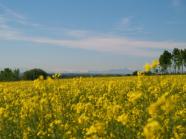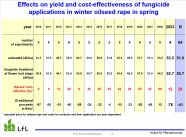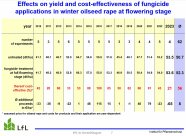Diseases and pests in winter oilseed rape

When these pests reappear in spring a rapid action is often required. The following overview shows what to pay particular attention to. Potential causes for important diseases and corresponding possible control measures are listed. In addition a summary of currently registered fungicides and growth regulators in winter oilseed rape is enclosed.
Stem pests
Scheduling insecticide application against stem pests
Fungicides and growth regulators
Which is the best date for fungicide and growth regulator application in autumn?
Principle: Mistakes made in cultivation cannot be compensated by fungicide treatments.
weak crops as a result of
- inappropriate seedbed preparation
- late sowing
- capping of soil surface that hinders crop to establish after sowing
- drought after seeds germinate (azoles forward growth of plants)
lush oilseed rape crops (oversupply of N)
- early and heavy infestation with Phoma lingam
- sites with frequent black frosts (plants treated with azol show a better winter hardiness)
Date of treatment in autumn
Ideal date of spraying is the six-leaf stage of the oilseed rape (last week of September – first week of October!)
product/application rate
winter hardiness/growth:
- Architect 1.6 l/ha
- Carax 0.5 l/ha
- Efilor 0.7 l/ha
- Folicur 1.0 l/ha
- Orius 1.5 l/ha
- Tilmor 1.2 l/ha
growth regulator:
- Architect 1.6 l/ha
- Carax 0.5 l/ha
- Efilor 0.7 l/ha
- Folicur 1.0 l/ha
- Orius 1.5 l/ha
- Tilmor 1.2 l/ha
- Toprex 0.5 l/ha
fungicide effect:
- Amistar Gold 1.0 l/ha
- Cantus Ultra 0.8 l/ha
- Caramba 1.5 l/ha
- Carax 1.0 l/ha
- Efilor 1.0 l/ha
- Folicur 1.5 l/ha
- Helocur 1.5 l/ha
- Orius 1.5 l/ha
- Tilmor 1.2 l/ha
- Toprex 0.5 l/ha
Effects on yield and cost-effectiveness of fungicide applications in winter oilseed rape in autumn (Preliminary result)
 Zoombild vorhanden
Zoombild vorhanden
fungicide applications in winter oilseed rape in autumn
Which is the best date for fungicide and growth regulator application in spring?
Principle: Mistakes made in cultivation cannot be compensated by fungicide treatments
crops with a higher danger of lodging
- raised supply of N (livestock farming)
- plant density is too high
- varieties that are less resistant to lodging
development of plants is unevenly (azoles produce a more evenly course of flowering and maturation)
strong infestation with stem pests
- promotes fungal diseases (Phoma lingam, Botrytis cinerea)
- reduced lodging resistance
long-time narrow crop rotation (over 25% oilseed rape) and crops developed too well before winter
Date of treatment in spring
Ideal date for spraying is inflorescence emergence stage of oilseed rape (BBCH 39-55; plants 40-50 cm high)
product/application rate
- Amistar Gold 1.0 l/ha
- Architect 1.6 l/ha
- Cantus Ultra 0.8 l/ha
- Caramba 1.5 l/ha
- Carax 1.0 l/ha
- Chamane 1.0 l/ha
- Efilor 1.0 l/ha
- Folicur 1.5 l/ha
- Helocur 1.5 l/ha
- Moddus 1.5 l/ha
- Orius 1.5 l/ha
- Tilmor 1.2 l/ha
- Toprex 0.5 l/ha
- Torero 1.0 l/ha
tank mixture
- Caramba 0.75 l/ha+Moddus 0.5 l/ha
- Folicur 0.75 l/ha+Moddus 0.5 l/ha
Effects on yield and cost-effectiveness of fungicide applications in winter oilseed rape in spring (Preliminary result)
 Zoombild vorhanden
Zoombild vorhanden
fungicide applications in winter oilseed rape in spring
When to use fungicides against Sclerotinia white stem rot?
Principle: A systematic treatment according to a damage threshold or a forecasting concept is not possible at present!
endangered sites
- oilseed rape in narrow crop rotation
- sunflowers within crop rotation
- valleys (high air humidity)
but: even especially endangered sites remain with a low infestation rate if weather conditions are favourable
date of treatment against Sclerotinia white stem rot
ideal date of spraying is the stage of full flowering (BBCH 65)
product / application rate
- Amistar Gold 1.0 l/ha
- Azbany 1.0 l/ha
- Cantus Ultra 0.8 l/ha
- Caramba 1.5 l/ha
- Chamane 1.0 l/ha
- Custodia 1.0 l/ha
- Efilor 1.0 l/ha
- Folicur 1.0 l/ha
- Intuity 0.8 l/ha
- Orius 1.5 l/ha
- Ortiva 1.0 l/ha
- Proline 0.7 l/ha
- Prosaro 1.0 l/ha
- Sinstar 1.0 l/ha
- Torero 1.0 l/ha
- Treso 0.75 kg/ha
Effects on yield and cost-effectiveness of fungicide applications in winter oilseed rape at full flowering stage (Preliminary result)
 Zoombild vorhanden
Zoombild vorhanden
fungicide applications in winter oilseed rape at full flowering stage
Summary
- optimal sowing is required for maximum yield
- control of stem pests is a cost-effective measure in general
- fungicides and growth regulators have an insurance aspect (with hybrid varieties production related efforts are more likely to be profitable)
- high oilseed rape yields require a “healthy crop rotation” (25% of oilseed rape)








